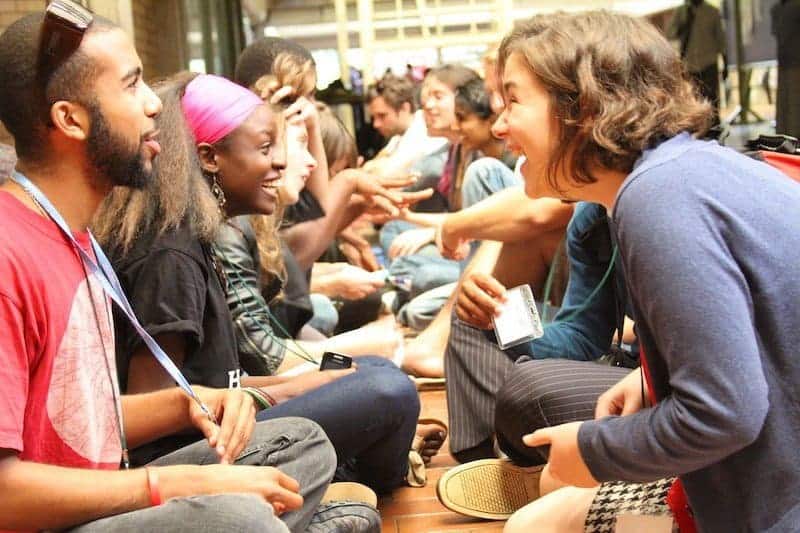How To Do Mindfulness Meditation To Reduce Distractions
Take Control of Your Inner Distractions
All day we are bombarded with the temptation to be distracted by technology, people, and especially by ourselves.
Do you have dozens of thoughts running through your head throughout the day?
Are you even aware that you do this?
- Oh! I need to pick up groceries.
- Oh! I need to think about what I will cook for dinner.
- Oh! I need to send that email!
When we break our focus, even on something small, we lose momentum on the task that we were working on.
Being present in the moment allows you to be aware of your surroundings, but NOT let them distract you.
Studying mindfulness meditation techniques will flex your mental muscles and teach you how to be present.
When you are present, you can focus your mental energy on a task or situation.
You train yourself to treat mental and physical stimuli as neither good nor bad – they simply are.
Mindfulness Meditation Basics
Mindfulness refers to the ability to step away from the current situation and observe what is happening, but without judging or interacting with it.
It requires that you be present in the moment; NOT in the past, NOT in the future.
If you don’t have any experience with mindfulness or meditation, don’t worry!
As you read this meditation guide, we will detail the basics to help you go from a head full of angry buzzing ideas, to a head full of clarity and decisiveness.
When You Think You Are Multitasking, You Are Actually More Likely to Build Anxiety!
This is a principal that applies all throughout life: from work, learning, to skateboarding, even talking to the opposite sex.
Think about the last time you went up to talk to a cute guy/girl.
Instead of being present in the moment, did you start thinking of all the past times you said the wrong thing and were rejected?
If so, I bet that interaction didn’t go well.
The practice of mindfulness is simply being aware of what is happening right now.
You are training yourself to be present in the moment, NOT thinking about the past or future.
When problems arise, you can block out distractions and crush your tasks.
Ditch The Clichés
“Most people assume that meditation is all about stopping thoughts, getting rid of emotions, somehow controlling the mind. But actually, it’s about stepping back, seeing the thought clearly, witnessing it coming and going.”
– Andy Puddicombe
It is common for people to have an image in their head of someone who meditates: a bald man in a robe, sitting on a cliff, who spent a decade developing his ability to sit still.
In fact, the truth is quite different.
Learning to meditate is not as difficult as you think.
You can practice any time during the day.
Simply take a few moments and focus on your surroundings (sights, sounds, smells) and your thoughts.
What you resists, persists” – Carl Jung (more CG Jung quotes)
Here’s something you will probably find counterintuitive to your idea of mindfulness meditation: don’t try to stop thoughts and “force” a clear mind.
Let thoughts arise, but don’t chase or interact with them.
Simply let them be.
Imagine little balloons rising past you.
If you don’t try to grab a balloon, it will eventually float away into the distance.
You will feel tense at first, but gradually the tension will subside!
For more inspiration, we also have a collection of thoughtful meditation quotes.
Don’t forget to check that out.
How To Do Mindfulness Meditation
Here is a simple 10-minute mindfulness meditation exercise for you to start improving your mental clarity, which will translate into sharper problem-solving and decision-making skills:
- Start a timer for 10 minutes and sit upright (a chair or on the floor is fine).
- Close your eyes and try to identify any sounds and smells in the room for a few minutes.
- Now imagine scanning from your head to your toes and try to mentally check in with each body part.
- Start counting your breaths at your normal breathing pace.
- Once you reach 10 breaths, start over at 1.
- After a few minutes, let your mind wander and do not judge – remember the balloons!
- When the timer goes off, slowly bring your focus back to yourself, the room around you, and then open your eyes.
Boom!
Done.
If you can practice that a few times per week, you will feel your mental muscles become more limber.
Don’t think you’re going to become an emotionless robot.
Now, when something stressful is happening, you can observe the situation without judging or feeling emotionally tied.
What Does It All Mean?
Imagine that you stepped into a puddle.
The awareness that your foot is now wet does NOT make your foot suddenly dry.
But with your new mindfulness meditation skills, you acknowledge the situation and move forward to find a remedy – without drowning in a flood of thoughts on why you shouldn’t have stepped in that puddle.
Great!
Now you know how to be present in the moment.
When you see that cute guy/girl, your focus will be on the present, your anxiety will fade away, and you will come across as cool, confident, and successful.
When your deadline is approaching and your resources are running low, you won’t let your emotions fog your mental clarity.
Conclusion
It feels awkward at first, but every skill requires investment.
If you want to get good at doing pull ups, guess what: you have to do more pull ups.
If you want to train your mind to resist distraction and remain focused on what is happening in the present, you have to practice it.
You may encounter a sticking point while you develop this skill.
Don’t worry; it is part of the process!
If you find yourself meditating and suddenly you’re running after a series of thoughts, acknowledge it and then bring the focus back to the present moment.
“The moment you realize you are not present, you are present” – Eckhart Tolle
You are training yourself to allow thoughts and emotions to arise, but without chasing them or judging them.
Thoughts simply are.
Imagine you’re sitting on a bench watching traffic.
As the cars drive by, stay seated.
Do not run after the cars; acknowledge them and let them pass.
Use mindfulness meditation and be the blade of grass in the wind.
You have the mental strength and flexibility to bend, but not break.











